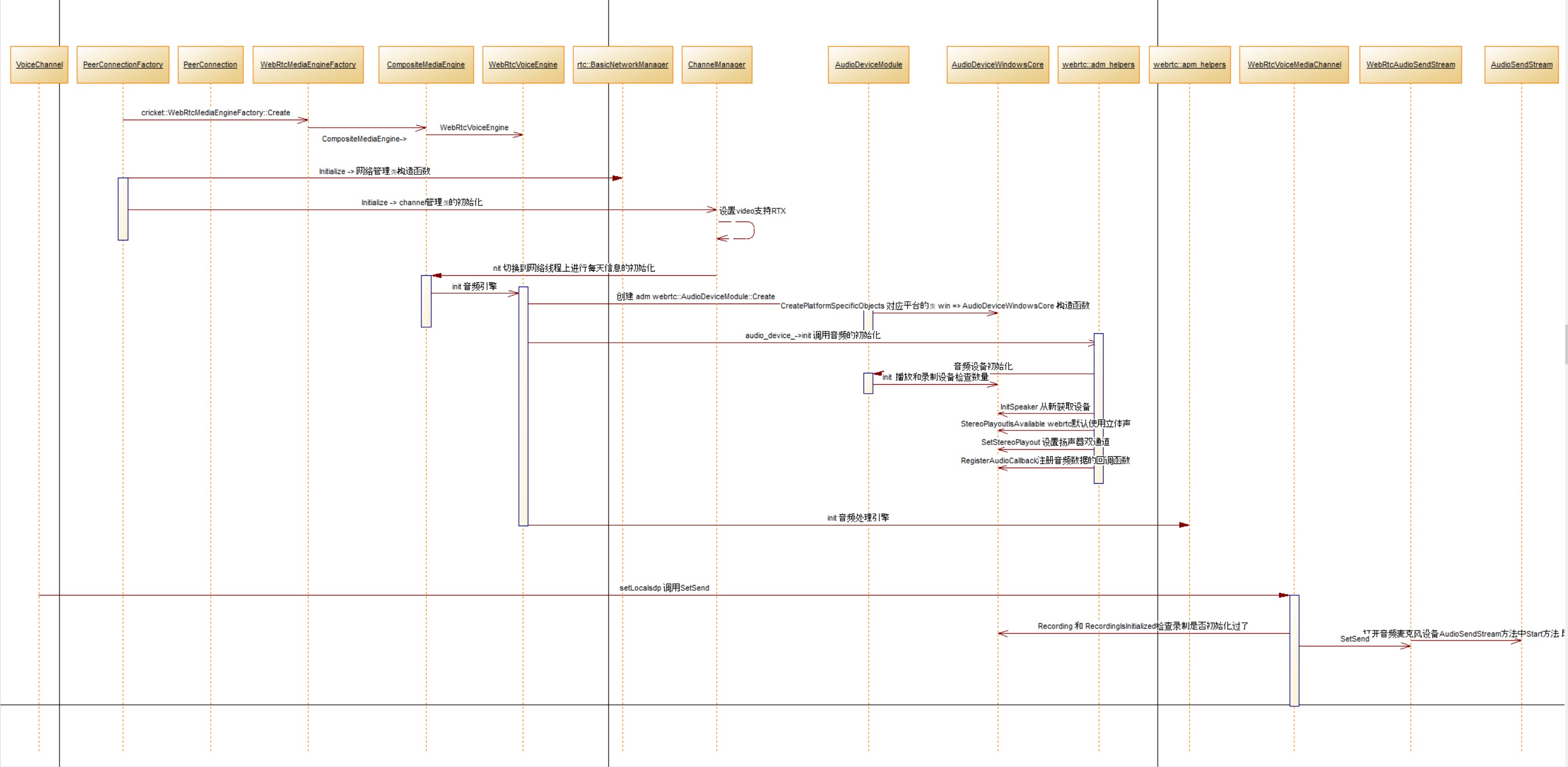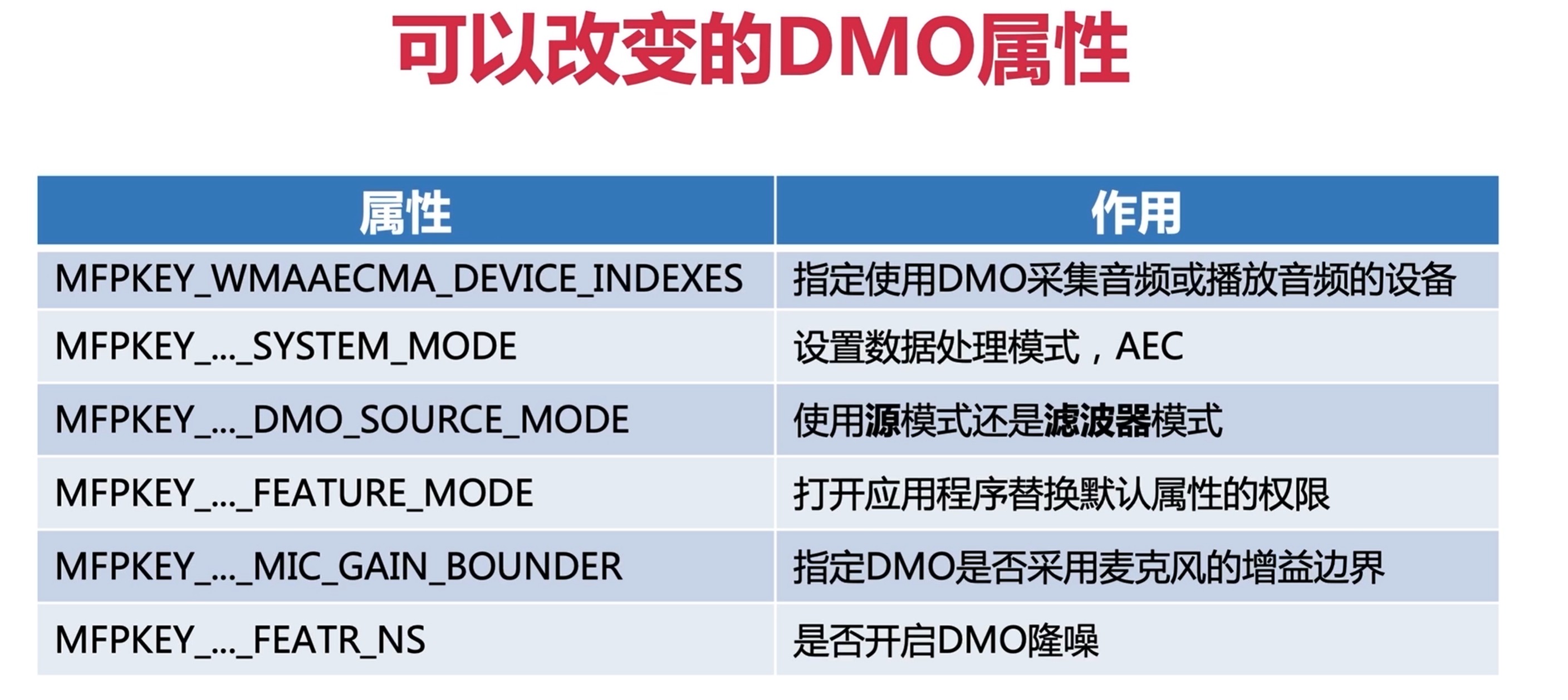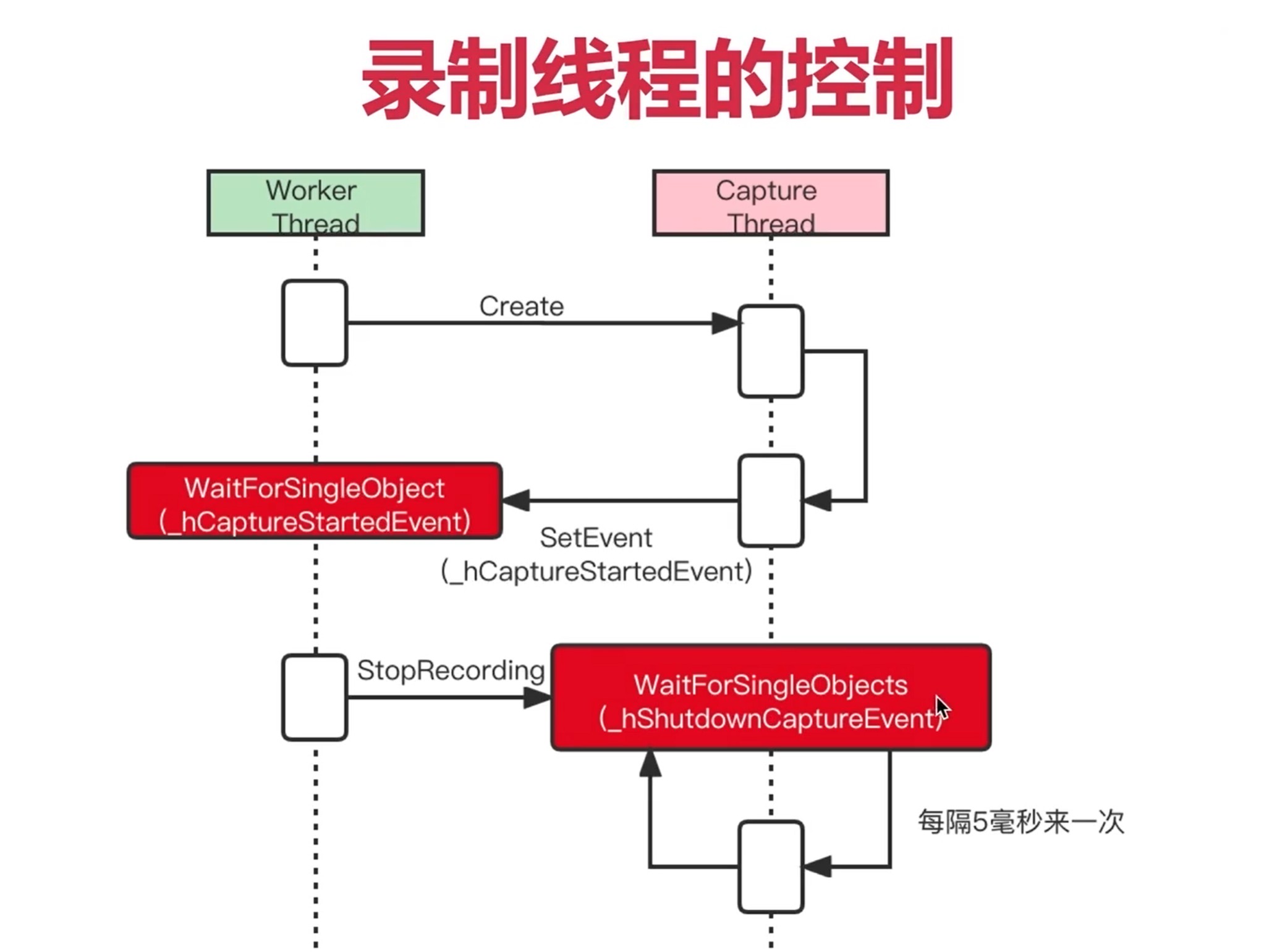WebRTC源码之音频设备的录制流程源码分析
WebRTC专题开嗨鸭 !!!一、 WebRTC 线程模型
2、WebRTC网络PhysicalSocketServer之WSAEventselect模型使用
二、 WebRTC媒体协商
2、WebRTC网络PhysicalSocketServer之WSAEventselect模型使用
3、WebRTC之证书(certificate)生成的时机分析
三、 WebRTC 音频数据采集
四、 WebRTC 音频引擎(编解码和3A算法)
五、 WebRTC 视频数据采集
六、 WebRTC 视频引擎( 编解码)
七、 WebRTC 网络传输
2、WebRTC的ICE之Dtls/SSL/TLSv1.x协议详解
八、 WebRTC服务质量(Qos)
3、WebRTC之NACK、RTX 在什么时机判断丢包发送NACK请求和RTX丢包重传
九、 NetEQ
十、 Simulcast与SVC
前言
WebRTC音频引擎启动基本流程图

一、音频DMO组件
- AEC 音频采集 硬件回音消除
- 麦克风阵列处理
- 噪音抑制
- 自动增益控制
- 语言活动检查
二、使用音频DMO的基本步骤 、分为三大步骤
### 1、初始化DMO 和接口音频DMO支持两个接口
- 音频DMO只支持IMediaObject和IPropertyStore接口
- IMediaObject 的CocreateInstance创建、这也是初始化
- IPropertyStore由DMO的QueryInterface创建
区分IPropertyStore接口
IMMDevice也有该接口、使用OpenPropertyStore获得
DEMO使用 QueryInterface获取该接口

① 、DMO的两种操作模式
- 源模式、所有的操作都交于DMO管理、从DMO取数据即可
- Filter模式、需要应用层主动发音频数据到DMO
DMO的初始化代码中InitRecordingDMO方法中
// Capture initialization when the built-in AEC DirectX Media Object (DMO) is
// used. Called from InitRecording(), most of which is skipped over. The DMO
// handles device initialization itself.
// Reference: http://msdn.microsoft.com/en-us/library/ff819492(v=vs.85).aspx
int32_t AudioDeviceWindowsCore::InitRecordingDMO() {
assert(_builtInAecEnabled);
assert(_dmo != NULL);
if (SetDMOProperties() == -1) {
return -1;
}
/* TODO@chensong 20220806 音频媒体数据结构的介绍
typedef struct _DMOMediaType
{
GUID majortype; // 流的主类型 GUID
GUID subtype; // 流的子类型 GUID
BOOL bFixedSizeSamples; // 采样是否是固定大小、音频为TRUE
BOOL bTemporalCompression; // 时域压缩 [音视频 分为时域和频域 视频==》【时域:时间顺序继续压缩 帧间压缩】【频域: 帧内压缩】]
ULONG lSampleSize; // 以字节为单位的采样大小
GUID formattype; // 数据格式类型, 音频为WAVEFORMATEX
IUnknown *pUnk; // 未使用
ULONG cbFormat; // 不同媒体类型格式块的大小
[size_is] BYTE *pbFormat; // 根据cbFormat决定该字段
} DMO_MEDIA_TYPE;
*/
DMO_MEDIA_TYPE mt = {};
/*
函数功能 : 初始化DMO_MEDIA_TYPE变量
参数1 : 需要初始化的DMO_MEDIA_TYPE对象指针
参数2 : 分配的格式块占有字节数
*/
HRESULT hr = MoInitMediaType(&mt, sizeof(WAVEFORMATEX));
if (FAILED(hr)) {
MoFreeMediaType(&mt);
_TraceCOMError(hr);
return -1;
}
mt.majortype = MEDIATYPE_Audio;
mt.subtype = MEDIASUBTYPE_PCM;
mt.formattype = FORMAT_WaveFormatEx;
// Supported formats
// nChannels: 1 (in AEC-only mode)
// nSamplesPerSec: 8000, 11025, 16000, 22050
// wBitsPerSample: 16
WAVEFORMATEX* ptrWav = reinterpret_cast<WAVEFORMATEX*>(mt.pbFormat);
ptrWav->wFormatTag = WAVE_FORMAT_PCM;
ptrWav->nChannels = 1;
// 16000 is the highest we can support with our resampler.
ptrWav->nSamplesPerSec = 16000;
ptrWav->nAvgBytesPerSec = 32000;
ptrWav->nBlockAlign = 2;
ptrWav->wBitsPerSample = 16;
ptrWav->cbSize = 0;
// Set the VoE format equal to the AEC output format.
_recAudioFrameSize = ptrWav->nBlockAlign;
_recSampleRate = ptrWav->nSamplesPerSec;
_recBlockSize = ptrWav->nSamplesPerSec / 100;
_recChannels = ptrWav->nChannels;
// Set the DMO output format parameters.
// TODO@chensong 20220806 音频DMO设备接口参数说明
// param 1 : 输出源索引值, 从0开始
// param 2 : DMO_MEDIA_TYPE 类型指针
// param 3 : 按位的组合标记,设置为0
hr = _dmo->SetOutputType(kAecCaptureStreamIndex, &mt, 0);
MoFreeMediaType(&mt);
if (FAILED(hr)) {
_TraceCOMError(hr);
return -1;
}
if (_ptrAudioBuffer) {
_ptrAudioBuffer->SetRecordingSampleRate(_recSampleRate);
_ptrAudioBuffer->SetRecordingChannels(_recChannels);
} else {
// Refer to InitRecording() for comments.
RTC_LOG(LS_VERBOSE)
<< "AudioDeviceBuffer must be attached before streaming can start";
}
_mediaBuffer = new MediaBufferImpl(_recBlockSize * _recAudioFrameSize);
// Optional, but if called, must be after media types are set.
hr = _dmo->AllocateStreamingResources();
if (FAILED(hr)) {
_TraceCOMError(hr);
return -1;
}
_recIsInitialized = true;
RTC_LOG(LS_VERBOSE) << "Capture side is now initialized";
return 0;
}
也是在InitRecordingDMO方法中实现的
①、如果使用filter模式,我们需要设置数据的输入格式
②、如果使用source模式则不需要设置输入数据的格式
③、两者都需要设置输出数据格式
④、 SetOutputType方法
是在SetOutputType方法中实现的
// param 1 : 输出源索引值, 从0开始
// param 2 : DMO_MEDIA_TYPE 类型指针
// param 3 : 按位的组合标记,设置为0
virtual HRESULT STDMETHODCALLTYPE SetOutputType(
DWORD dwOutputStreamIndex,
/* [annotation][in] */
_In_opt_ const DMO_MEDIA_TYPE *pmt,
DWORD dwFlags) = 0;
// 结构体的介绍
/* TODO@chensong 20220806 音频媒体数据结构的介绍
typedef struct _DMOMediaType
{
GUID majortype; // 流的主类型 GUID
GUID subtype; // 流的子类型 GUID
BOOL bFixedSizeSamples; // 采样是否是固定大小、音频为TRUE
BOOL bTemporalCompression; // 时域压缩
ULONG lSampleSize; // 以字节为单位的采样大小
GUID formattype; // 数据格式类型, 音频为WAVEFORMATEX
IUnknown *pUnk; // 未使用
ULONG cbFormat; // 不同媒体类型格式块的大小
[size_is] BYTE *pbFormat; // 根据cbFormat决定该字段
} DMO_MEDIA_TYPE;
*/
⑤、DMO_MEDIA_TYPE说明
子类型: MEDIASUBTYPE_PCM、 MEDIASUBTYPE_FLOAT
数据块格式: WAVEFORMAT、WAVEFORMATEX
采样率: 8000/11025/16000/22050
Channel: 1 AEC、 2/4麦克风阵列
采样位数: 16
⑥、MoInitMediaType方法 初始化MDMO_MEDIA_TYPE变量
int AudioDeviceWindowsCore::SetDMOProperties() {
HRESULT hr = S_OK;
assert(_dmo != NULL);
rtc::scoped_refptr<IPropertyStore> ps;
{
IPropertyStore* ptrPS = NULL;
hr = _dmo->QueryInterface(IID_IPropertyStore,
reinterpret_cast<void**>(&ptrPS));
if (FAILED(hr) || ptrPS == NULL) {
_TraceCOMError(hr);
return -1;
}
ps = ptrPS;
SAFE_RELEASE(ptrPS);
}
// Set the AEC system mode.
// SINGLE_CHANNEL_AEC - AEC processing only.
// 修改DMO得属性 使用AEC模式
if (SetVtI4Property(ps, MFPKEY_WMAAECMA_SYSTEM_MODE, SINGLE_CHANNEL_AEC)) {
return -1;
}
// Set the AEC source mode.
// VARIANT_TRUE - Source mode (we poll the AEC for captured data).
// 工作模式得设置 使用filter模式
if (SetBoolProperty(ps, MFPKEY_WMAAECMA_DMO_SOURCE_MODE, VARIANT_TRUE) ==
-1) {
return -1;
}
// Enable the feature mode.
// This lets us override all the default processing settings below.
// 我们应用是否允许修改属性 可以修改得
if (SetBoolProperty(ps, MFPKEY_WMAAECMA_FEATURE_MODE, VARIANT_TRUE) == -1) {
return -1;
}
// Disable analog AGC (default enabled).
// 是否使用增益边界 WebRTC中使用增益
if (SetBoolProperty(ps, MFPKEY_WMAAECMA_MIC_GAIN_BOUNDER, VARIANT_FALSE) ==
-1) {
return -1;
}
// Disable noise suppression (default enabled).
// 0 - Disabled, 1 - Enabled
// 是否使用降燥 WebRTC中是使用自己得降燥模块得
if (SetVtI4Property(ps, MFPKEY_WMAAECMA_FEATR_NS, 0) == -1) {
return -1;
}
// Relevant parameters to leave at default settings:
// MFPKEY_WMAAECMA_FEATR_AGC - Digital AGC (disabled).
// MFPKEY_WMAAECMA_FEATR_CENTER_CLIP - AEC center clipping (enabled).
// MFPKEY_WMAAECMA_FEATR_ECHO_LENGTH - Filter length (256 ms).
// TODO(andrew): investigate decresing the length to 128 ms.
// MFPKEY_WMAAECMA_FEATR_FRAME_SIZE - Frame size (0).
// 0 is automatic; defaults to 160 samples (or 10 ms frames at the
// selected 16 kHz) as long as mic array processing is disabled.
// MFPKEY_WMAAECMA_FEATR_NOISE_FILL - Comfort noise (enabled).
// MFPKEY_WMAAECMA_FEATR_VAD - VAD (disabled).
// Set the devices selected by VoE. If using a default device, we need to
// search for the device index.
// 设置输入设备和输出设备的id
int inDevIndex = _inputDeviceIndex;
int outDevIndex = _outputDeviceIndex;
if (!_usingInputDeviceIndex) {
ERole role = eCommunications;
if (_inputDevice == AudioDeviceModule::kDefaultDevice) {
role = eConsole;
}
// 获取设备id
if (_GetDefaultDeviceIndex(eCapture, role, &inDevIndex) == -1) {
return -1;
}
}
if (!_usingOutputDeviceIndex) {
ERole role = eCommunications;
if (_outputDevice == AudioDeviceModule::kDefaultDevice) {
role = eConsole;
}
// 获取设备id
if (_GetDefaultDeviceIndex(eRender, role, &outDevIndex) == -1) {
return -1;
}
}
// 把输入设备和输出设备放到devIndex中
DWORD devIndex = static_cast<uint32_t>(outDevIndex << 16) +
static_cast<uint32_t>(0x0000ffff & inDevIndex);
RTC_LOG(LS_VERBOSE) << "Capture device index: " << inDevIndex
<< ", render device index: " << outDevIndex;
// 设置设备的值到DMO中去, DMO使用那个输入设备或者那个输出设备id
if (SetVtI4Property(ps, MFPKEY_WMAAECMA_DEVICE_INDEXES, devIndex) == -1) {
return -1;
}
return 0;
}
①、在处理数据前, 需要调用ALLocate Streaming Resource方法
②、AllocateStreamingResource 分配的资源由DMO内部使用
③、如果使用filter模式,需要调用ProcessInput向DMO传数据
获取输出数据
- 创建Buffer来获得输出数据、该Buffer实现了IMediaBuffer接口
- 清空DMO_OUTPUT_DATA_BUFFER中数据,防止有脏数据
- DMO_…_BUFFER中pBUffer成员指向你自己的Buffer
- 将DMO_…_BUFFER转给ProcessOut方法
- 通过上面步骤持续从DMO中获取数据
在[moudles/audio_device/win/audio_decvice_core.cc]DoCaptureThreadPollDMO中实现
DWORD AudioDeviceWindowsCore::DoCaptureThreadPollDMO() {
assert(_mediaBuffer != NULL);
bool keepRecording = true;
// Initialize COM as MTA in this thread.
ScopedCOMInitializer comInit(ScopedCOMInitializer::kMTA);
if (!comInit.succeeded()) {
RTC_LOG(LS_ERROR) << "failed to initialize COM in polling DMO thread";
return 1;
}
HRESULT hr = InitCaptureThreadPriority();
if (FAILED(hr)) {
return hr;
}
// Set event which will ensure that the calling thread modifies the
// recording state to true.
SetEvent(_hCaptureStartedEvent);
// >> ---------------------------- THREAD LOOP ----------------------------
while (keepRecording) {
// Poll the DMO every 5 ms.
// (The same interval used in the Wave implementation.)
DWORD waitResult = WaitForSingleObject(_hShutdownCaptureEvent, 5);
switch (waitResult) {
case WAIT_OBJECT_0: // _hShutdownCaptureEvent
keepRecording = false;
break;
case WAIT_TIMEOUT: // timeout notification
break;
default: // unexpected error
RTC_LOG(LS_WARNING) << "Unknown wait termination on capture side";
hr = -1; // To signal an error callback.
keepRecording = false;
break;
}
while (keepRecording) {
rtc::CritScope critScoped(&_critSect);
DWORD dwStatus = 0;
{
/*
typedef struct _DMO_OUTPUT_DATA_BUFFER
{
IMediaBuffer *pBuffer; // 指向由应用分配的支持IMediaBuffer接口的BUffer
DWORD dwStatus; // 处理输出后, DMO修改该标记
REFERENCE_TIME rtTimestamp; // 指明数据在该BUffer中的开始时间戳
REFERENCE_TIME rtTimelength; // 指定BUffer中数据长度的参考时间
} DMO_OUTPUT_DATA_BUFFER;
*/
DMO_OUTPUT_DATA_BUFFER dmoBuffer = {0};
dmoBuffer.pBuffer = _mediaBuffer;
dmoBuffer.pBuffer->AddRef();
// Poll the DMO for AEC processed capture data. The DMO will
// copy available data to |dmoBuffer|, and should only return
// 10 ms frames. The value of |dwStatus| should be ignored.
hr = _dmo->ProcessOutput(0, 1, &dmoBuffer, &dwStatus);
SAFE_RELEASE(dmoBuffer.pBuffer);
dwStatus = dmoBuffer.dwStatus;
}
if (FAILED(hr)) {
_TraceCOMError(hr);
keepRecording = false;
assert(false);
break;
}
ULONG bytesProduced = 0;
BYTE* data;
// Get a pointer to the data buffer. This should be valid until
// the next call to ProcessOutput.
hr = _mediaBuffer->GetBufferAndLength(&data, &bytesProduced);
if (FAILED(hr)) {
_TraceCOMError(hr);
keepRecording = false;
assert(false);
break;
}
if (bytesProduced > 0) {
const int kSamplesProduced = bytesProduced / _recAudioFrameSize;
// TODO(andrew): verify that this is always satisfied. It might
// be that ProcessOutput will try to return more than 10 ms if
// we fail to call it frequently enough.
assert(kSamplesProduced == static_cast<int>(_recBlockSize));
assert(sizeof(BYTE) == sizeof(int8_t));
_ptrAudioBuffer->SetRecordedBuffer(reinterpret_cast<int8_t*>(data),
kSamplesProduced);
_ptrAudioBuffer->SetVQEData(0, 0);
_UnLock(); // Release lock while making the callback.
_ptrAudioBuffer->DeliverRecordedData();
_Lock();
}
// Reset length to indicate buffer availability.
hr = _mediaBuffer->SetLength(0);
if (FAILED(hr)) {
_TraceCOMError(hr);
keepRecording = false;
assert(false);
break;
}
if (!(dwStatus & DMO_OUTPUT_DATA_BUFFERF_INCOMPLETE)) {
// The DMO cannot currently produce more data. This is the
// normal case; otherwise it means the DMO had more than 10 ms
// of data available and ProcessOutput should be called again.
break;
}
}
}
// ---------------------------- THREAD LOOP ---------------------------- <<
RevertCaptureThreadPriority();
if (FAILED(hr)) {
RTC_LOG(LS_ERROR)
<< "Recording error: capturing thread has ended prematurely";
} else {
RTC_LOG(LS_VERBOSE) << "Capturing thread is now terminated properly";
}
return hr;
}

总结:
WebRTC源码分析地址:https://github.com/chensongpoixs/cwebrtc